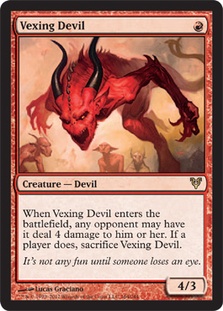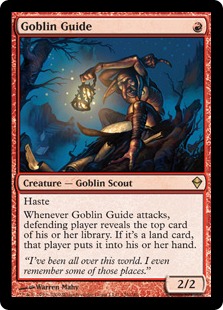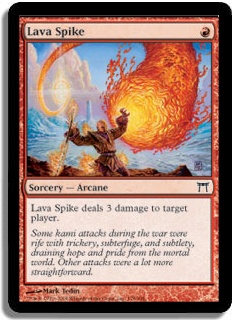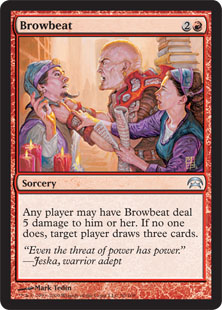What’s Your Opinion?
It begins like clockwork at the stroke of midnight.
In the weeks leading up to the release of every new Magic set, I hit "refresh" on the Wizards of the Coast website at the start of every new day. Heart thumping, I skip past a few dozen lines of text and click on the link that reveals the latest preview card. For a few glorious minutes, I get to revel in the possibilities of each brand new card without having had my opinion tainted by anything or anyone.
I read somewhere that the amount of information a man or woman in the Middle Ages would have been exposed to over their entire lifetime would fit inside a single newspaper. True or not, it’s indisputable that the modern era is nothing short of an information overload. I read hundreds of different websites each day and parse thousands of thoughts on everything from third world genocide to Batman outtakes.
Because this information bombardment comes on top of a 24-hour news cycle and an unhealthy obsession with social media, I find myself being exposed to hundreds of opinions on issues that I know very little about. Then I am asked to give my own opinion on those very same things. Most of the time I just synthesize the two or three best things I’ve read into something resembling a thought and pretend that I know what I’m talking about.
There are just too many things going in the world today, and it’s impossible to have an informed opinion on all of them.
This is especially true when it comes to Magic preview cards. Generally, the bedrock of our opinion comes from the article on the Wizards website that introduces the card. Because Wizards wants their customers to be excited about the latest set, these articles speak to each card’s best-case scenario without addressing their downsides. Then we turn to Facebook or Twitter and see a few dozen people like Doom Blade Guy talking up all the reasons why we shouldn’t get too excited just yet.
Then, if you’re anything like me, you’ll read an article by a deckbuilder or pro you respect and see what they have to say. After that, you probably won’t spend too much time thinking about the card again until you open it in a Limited event or see it start to crop up in decklists.
This is enough if you just want to play Standard, but if you want to gain an edge in finance—and in understanding the future of the format for that matter—you should strive to break that habit and learn how to evaluate cards on your own.
In this article, I am going to walk you through the steps I personally use to evaluate cards. Hopefully some of these tips will be valuable additions to your own thought process. At any rate, this should give you a good glimpse into what I consider when I decide to buy or sell a card on spec in the early days of a given set. Â
New Beginnings
Before launching into the meat of the article, I want to take a moment and introduce myself. My name is Chas Andres, and I’ve been writing Magic finance articles for about two years now. I’m absolutely thrilled to have landed here at StarCityGames.com.
I’m a screenwriter by trade, and my Magic career remains firmly rooted in the hobbyist realm of FNM duels and weekend Cube drafts. I graduated from Emerson College in Boston, and I’m currently living in Los Angeles and working in the television industry.
I moved to LA in the summer of 2008 and signed my first adult apartment lease on the day Lehman Brothers went under. It took me almost a year to find work, and in that time I supported myself—and even grew my savings—by buying, selling, and trading Magic cards.
Nowadays, I just trade for fun. I’m a handful of cards away from completing my 720-card all-original-set-foil cube, and last fall I finished trading a pack of Zendikar up to an Alpha Mox Sapphire. I’m a collector at heart, and I love anything rare, cool, old, valuable, or unique.
Do not read this column expecting a bunch of advice on how to bully your way to outrageous trades. I abhor the culture of ‘bully trading’ that’s been on the rise over the past several years, and I firmly believe that ripping off children and new players is the fastest way to destroy our community.
My goal is to help you build your collection through critical thinking, objective analysis, and smart maneuvering. These are the values that my column will strive to teach, along with a healthy dose of bad television, pop psychology, nerd culture, new wave music, and probably some rambling about why Magic finance is just like one my ex-girlfriends.
If you like my analysis or writing, I urge you to follow me on Twitter. Magic finance often moves fast, and Twitter is the best tool we currently have for the quick dissemination of information.
With all that out of the way, let’s get back to the good stuff. Whenever a new set is released, here’s what I do first.
How I Evaluate Cards
There are several different things I consider when evaluating a brand new card. For example, let’s take a long look the following creature:
The Historical Comparison
My initial reaction in analyzing a card like this is to compare it to similar spells throughout history. At first glance, it appears that Vexing Devil is most similar to these three spells:
Why these three? Well, early in a game Vexing Devil is likely going to be an improved Lava Spike. Most players aren’t going to want to deal with a 4/3 that comes out on turn 1, so they’ll just take the life hit and move on. Late in the game, when both sides likely have multiple creatures in play, Vexing Devil will act as an improved Goblin Guide. You won’t be able to burn a player out with it like Lava Spike, but it will certainly add an impressive body to the board for almost no cost.
This brings us to Browbeat. Historically, Browbeat has always been one of the biggest traps in Magic. On the surface, the card seems incredible—what burn deck wouldn’t want to draw three cards or deal five damage? Both modes are incredible, right? Unfortunately, if you play with the card enough, you’ll quickly realize that giving your opponent that choice is more important than you think. This is what blue decks have been exploiting for years; in Magic, as in life, the ability to make choices is absurdly powerful.
Of course, as Magic financiers we don’t need a card to be amazing to be valuable. It’s not quality that drives prices, but demand—and there is often a huge difference.
Consider Phyrexian Obliterator. For almost a year, that card was nearly unplayable in Standard. Yet because mono-black is so popular in casual formats, you could trade Obliterators at $20 all night long. It didn’t matter that Phyrexian Obliterator hadn’t lived up to its potential because enough people wanted to keep trying.
Or heck, consider Browbeat itself. The card has been so popular over the years; it’s seen print a whopping five different times and is still worth $2-$3 depending on the edition. The fact that this card compares favorably to Browbeat, albeit at a different point on the curve, gives me high hopes for Vexing Devil to stick it out as a popular card.
The Format Comparison
A quick look at the Magic Online events coverage tells me that aggressive red decks simply aren’t good in Standard right now.
It’s important to note that red is almost always a disproportionately higher part of the metagame online than in person because the cards tend to be cheaper to acquire. When red doesn’t show up online much at all, that’s usually a good sign that the deck is not a real player in the format.
Burn is very real in Modern, however, and people will always play it in Legacy as well. Because Vexing Devil compares favorably to so many red Eternal staples, you will be able to count on people attempting to make the card work in every format. If it ends up being more powerful than expected, there will likely be a rise in the price of other cards that the deck will need—Hellrider, for example, or foil copies of Brimstone Volley.
It’s important to note that this card is useless in Commander, but Cube builders may want foil copies if it lives up to its potential.
The Set Comparison
As of this writing, there is only one other red card spoiled in Avacyn Restored: Thunderous Wrath. This card is also likely Constructed playable, as Burn decks will generally be okay using their one-mana Lava Axe off the top every time. It’s important to keep an eye on other cards that might fit with Vexing Devil as the spoiler comes out. Burn decks especially are always a card or two away from being very good.
It’s also important to get a sense of how much helium the set has. While in print, Magic sets all have a value ceiling: the average cost of the rares cannot exceed the cost of a pack. This generally means that you’re going to see a lot more price regression in sets with a ton of hyped-up rares; Ravnica, City of Guilds was like that. In a set without many high value cards—think Dark Ascension—the cards that start out being valuable are more likely to stay that way.
The Value Comparison
After analyzing all of these variables, it’s time to think about what Vexing Devil should be worth. As a large set rare, it does have a lower ceiling than most mythics, but it’s important to note that this set will be drafted only as much as Rise of the Eldrazi and far less than Innistrad and Scars of Mirrodin. Also, with large set rares like Darkslick Shores sitting at $18, the ceiling on these is higher than we had all thought earlier in the mythic era.
Worst case, Vexing Devil sees no play and casual Magicians bore of it. Even still, I can’t see it falling below $1.50. A more realistic floor is probably the $5 that Stromkirk Noble is currently selling for.
Best case, Mono Red becomes the defining deck of Avacyn Restored Standard. With Vexing Devil as a flagship, the card reaches the $18-$20 heights of Figure of Destiny.
Realistically, Vexing Devil will likely follow a path similar to Goblin Guide. As one of the crucial cards in a very good deck, it will probably bounce between $5 and $12 depending on that week’s tournament results. The fact that it’s in a third set may boost the ceiling a bit. If the deck is ever tier one, Vexing Devil could stay stable at $15.
A quick check of the StarCityGames.com store shows Vexing Devil pre-selling at $15, up from $10 when it was originally spoiled. Considering how much is unknown right now, this price feels like the top of the market. With a realistic floor of $5 and a realistic ceiling of $15, buying in at $15 is not likely to be a good idea. Buying in at $10, when the card was originally spoiled, would have been reasonable if you were planning on playing it for a season. Otherwise, though, there is no place for it to go but down.
Granted, you could come to a similar conclusion just by looking at the price and thinking about past cards, but by doing your own evaluation you now have a good sense of what the card is and what sort of place it has in the metagame. Now that you’ve spent some time figuring out Vexing Devil, you’ll be able to make sense of where its price moves from here—and why.
Of course, not all cards will be priced accurately from the start. And if you take the time to evaluate them all, you might stumble upon something wonderful.
Sleepers
A "sleeper" is a card that is initially undervalued but will come to be worth a lot. Stoneforge Mystic was a sleeper. So was Frost Titan.
Primeval Titan, expensive and in demand from the day he was spoiled, was not.
In Magic finance, properly identifying a sleeper and backing up your call with a speculative purchase is one of the most lucrative things you can do. Buying 700 Spellskites for 25 cents each is the stuff that dreams are made of.
Of course, most speculative purchases don’t end up panning out. I still have enough copies of Daybreak Ranger to power a steam locomotive from Scranton to East Bend, and I don’t expect Scarblade Elite to go up in price anytime soon.
Over the years, I’ve come to notice a few things that sleepers tend to have in common. Keep these in mind while you’re looking over the latest spoiler and perhaps you’ll spot your own.
The Weak Link Sleeper
Examples: Frost Titan ($4 at release), Inferno Titan ($5 at release)
When a cycle is first spoiled, most of the attention will be placed on the cards that appear to be the most powerful. In the lead-up to the release of M11, Grave Titan and Primeval Titan were the belles of the ball simply because their overt power was easier to spot.
While both of the "lesser" Titans are reasonably cheap today, Uncle Frosty and his fiery friend each spent months of their time in Standard at $15 or higher. In fact, much of the pre-Innistrad metagame in Standard was simply a fight over which Titan was the right play in a given week.
It’s important to remember that you’re evaluating a card in relation to all of the other cards in a format, not just the others in its cycle. While Frost Titan’s ability seemed underwhelming next to a couple of flashier alternatives, that still didn’t make it a bad card.
The Information Dump Sleeper
Examples: Batterskull ($5 at release), Hellrider ($1 at release)
Most of the best cards in each set are given "official" spoilers, meaning that they each have a preview article on magicthegathering.com or one of the numerous Magic fan sites. As such, the community is given a lot of time to parse and digest each one in turn. A card like Temporal Mastery may or may not end up being good, but it will certainly be evaluated by thousands of people before Avacyn Restored hits the stands.
In the week leading up to the Prerelease, Wizards generally releases the names and stats on the remaining cards without too much fanfare. This is generally where you get ten or fifteen bulk rares spoiled in a day, and most sites put them up for sale without too much thought. This also happened when the New Phyrexia god book was leaked and the online retailers didn’t want to miss out on a horde of excited consumers.
When too many cards are spoiled at once, especially without too much attention being paid to any of them, there’s a good chance that there might be one or two gems flying in under the radar. While everyone else focuses on the splashy rares spoiled at the start of the first week of previews, it’s far more lucrative for you to look closer at the cards that aren’t known until the very end.
The New Mechanic Sleeper
Examples: Spellskite (bulk rare at release), Garruk Wildspeaker ($4 at release)
When a card like Maelstrom Pulse or Path to Exile is spoiled, it doesn’t take a genius to realize it’s going to be good. Both of those cards—and countless other chase rares—are modified versions of spells that have been powerful in every format since they were first printed. If Wizards made a blue instant that read "UU — Counter target spell. Lose one life," you’d know right away that it was going to be good, right?
Sleeper potential is rarely present in cards that have good historical comps because everyone can properly evaluate them. It gets far trickier when looking at cards that bring something totally new to the table. Most people knew that Phyrexian mana was going to be good, but very few realized just how good—and most of those cards shot up in price when that discovery was made. Planeswalkers seemed powerful on the surface, but they also seemed a little casual and Timmy-ish to some.
If you can see the potential in a new mechanic before everyone else does, you’ll have a powerful advantage when it comes to identifying sleepers.
The Novelty Sleeper
Example: Tarmogoyf ($2 at release)
An offshoot of the new mechanic sleeper, I think Tarmogoyf went unnoticed for longer than it should have simply because it seemed like kind of a novelty card. This was the first card in Magic to mention planeswalkers and the first to mention tribal card types. Because of that, the card was analyzed more for what it promised about the future of the game than for its power level. Â
The Historically Unplayable Sleeper
Examples: Phantasmal Image ($2.50 at release), Elesh Norn, Grand Cenobite ($6 at release)
In card evaluation, context is everything. When looking at a card like Phantasmal Image, the most obvious comparisons are a billion other Clone effects from over the years, most of which have been too expensive to ever see play. Granted, Renegade Doppelganger had its moments in Dredge-uh-Vine, but Clone has almost always been a poor choice in Constructed formats.
As it turned out, the "phantasmal" drawback is negligible in Constructed and a two-mana Clone is actually quite good. But because Clones have been awful for so long, this little guy simply wasn’t properly evaluated until people started putting him in decks.
On the other end of the curve we get Elesh Norn, Grand Cenobite. This card was mostly dismissed for the opposite reason—its mana cost was deemed too prohibitive. The lack of evasion, protection, or a high power hurt it in the eyes of most control players, and Reanimator pilots compared it unfavorably to Jin-Gitaxias, Core Augur and Iona, Shield of Emeria. Historically, giant seven-drops like this just haven’t been good enough.
While much of Elesh Norn, Grand Cenobite’s success can be attributed to a format that is ramp-friendly and full of tokens to blow up, more and more players began realizing that Elesh Norn, Grand Cenobite’s ability is just a ton better than initially surmised. At this point, I would expect the card to see play in Modern and perhaps even in Legacy after rotation.
The Critical Mass Sleeper
Examples: Bitterblossom ($5 at release), Vendilion Clique ($5 at release)
If you weren’t playing Magic when Lorwyn came out, chances are you won’t believe me when I tell you how bad Faeries were. They were arguably the worst tribe in the set and saw pretty close to no Constructed play. So even though people liked Bitterblossom enough when the card was spoiled, the community’s lack of trust in Faeries kept the card from being a chase rare at first.
Whoops.
Turns out, sometimes all a deck needs are one or two cards to push it over the edge. People were down on Bitterblossom because Faeries were bad up until that point, not thinking whether or not Bitterblossom was enough to make them good. Once people figured out the deck, all the good Faerie cards—even the ones from Lorwyn that had previously been panned due to lack of support—saw a major jump in value.
The Safest Bets
Sleepers aren’t everything, of course. Most of the interesting cards in the set will be pre-selling for $10 or more long before they hit the shelves. If you’re the kind of player who likes to buy their chase cards early, how will you decide which ones to get? If you open a money card at the prerelease, how will you know whether or not to trade it away?
With low value sleepers, it’s all about targeting upside. If you’re picking up a set of cards for fifty cents each, get the rares that have a chance to be worth ten dollars, not the ones with an upside of a buck or two. This is why I always target cheap mythics early in the life cycle of a set.
With expensive cards, however, what you’re looking for is a pedigree. For example, Mutavault was a $20-$25 card when it was first spoiled. Pretty much everyone in Magic knew that it was going to be good because it compared so favorably to Mishra’s Factory. To date, there still hasn’t really been a time when you would have been disappointed to have bought a Mutavault; the card has dipped in value from time to time, but it never really came down from that initial price.
On the other side, you get a card like Skaab Ruinator. There’s never been another card quite like Skaab Ruinator, so there were no good comparisons to be made before release—the only thing you had to go on was hope and conjecture. While a new mechanic might lead to a sleeper hit from a dollar rare, I always trade away my high value "new mechanic" cards and let others assume the risk.
Oh—and never, ever invest in cards that don’t do anything when they come into play! You always think you’re going to have time to set them up, but rarely is that going to be the case.
When in doubt, bank on what you know tends to work. Regardless of the year or season, there are a handful of archetypes that are always on the fringe of playability. Someone is going to be rocking a U/W Tempo deck. U/B Control will be a thing. Mono-Red Aggro/Burn. G/x Ramp. Mono-Black Control. Even if these decks are terrible, chances are someone at your FNM will be running them. Betting on cards that are good in established archetypes is safer than pinning your hopes on the rise of something new.
Final Thoughts
I’ll be back soon with my Avacyn Restored financial set review, but until then I want you to take a good, long look at the cards for yourself. Take a deep breath, put on some soothing music (I recommend Oingo Boingo), and think—really think—about each card you see.
Ignore the experts for just a moment, forget about what dies to Doom Blade or what a beating something would be in narrowest possible circumstances, and use your own knowledge of the game to analyze the cards. Â
You might just be better at it than you thought.
Until next time —
— Chas Andres




